Pawscessories is reader-supported. When you buy via links on our site, we may earn an affiliate commission at no cost to you.
Learn more.
Do you have a puppy that is difficult to deal with on a leash? One that gets distracted easily, doesn’t pay attention to you, bites the leash, and constantly pulls?
It can be frustrating when we are putting in the time to train our pup but nothing seems to work. So what does it take to properly leash train a puppy and eliminate all the bad habits?
Here is a quick overview.
How To Leash Train A Puppy:
- Get Them Used To Their Collar And Leash
- Use A Puppy Line Inside
- Gather The Tools Needed
- Set An Appropriate Challenge
- Practice Proper Training
- Praise All Good Behavior
- Start Leash Walking In Control
- Be Tolerant Of Their Mistakes
- Know The Right Pace
- Use More Turning
- Plan How To End
In this article we discuss:
- A deep dive into how to leash train a puppy
- How to eliminate your puppies’ bad leash habits (pulling, biting, etc.)
- Whether or not you should a collar or harness
- And much more
Let’s get right into it.
Table of Contents
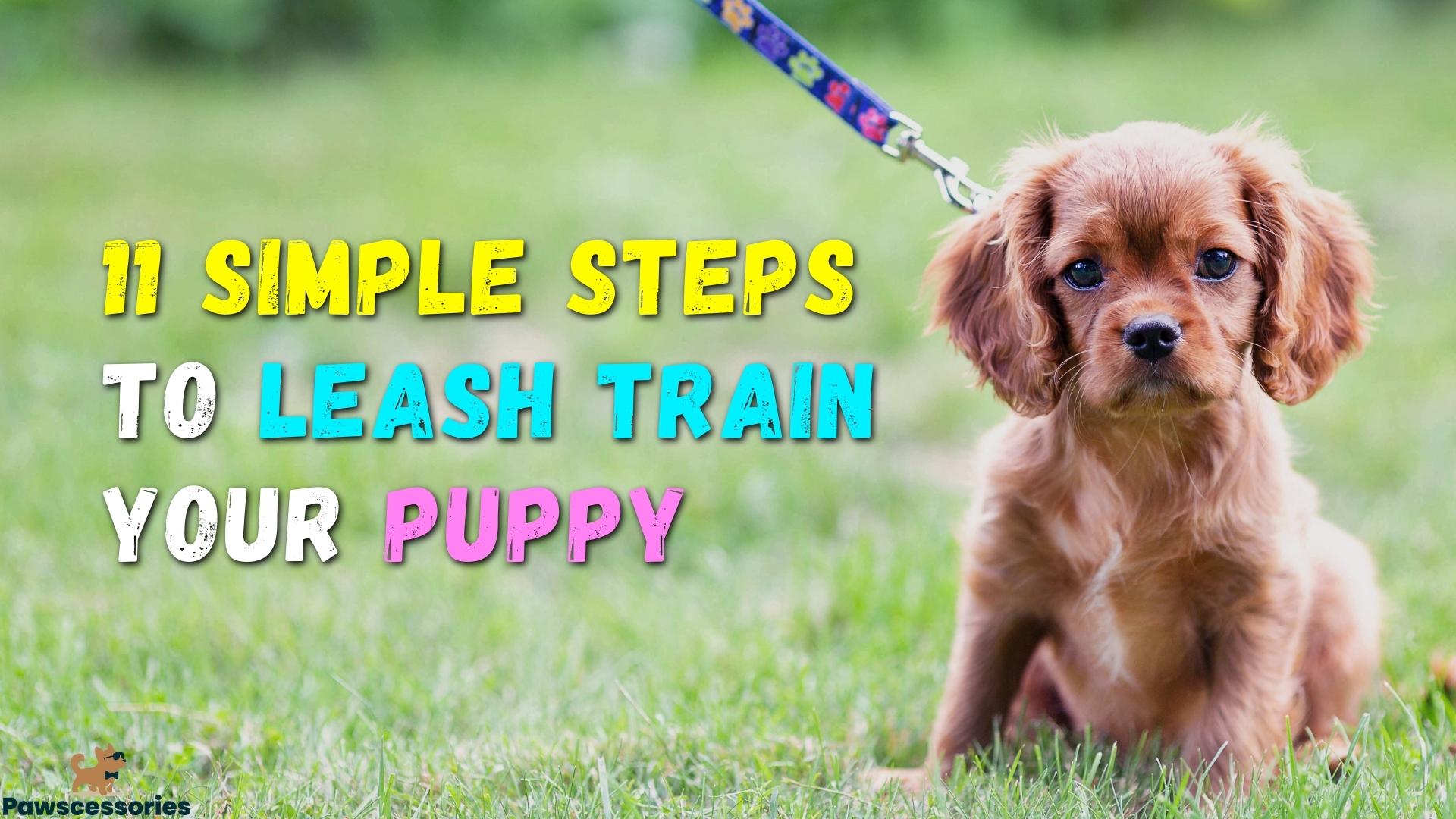
When Should You Start Leash Training A Puppy?
You want to start leash training at 8-16 weeks old. Before you even begin leash training you want to teach them the basic commands like, come, sit, stay, lie down, etc. This training is their foundation and will be important for when they begin leash training.
You can start leash training your puppy as early as 8 weeks old. However, you don’t want to take them on walks until they have all their vaccinations.
In addition, before you begin leash training teach them basic commands like, come, sit, stay and lie down. This training is their foundation and will be important for when they begin leash training.
Then when you begin leash training start inside your home. Once they get the hang of it take them on short walks around your neighborhood and slowly build up from there.
Leash Training A Puppy: 11 Simple Strategies
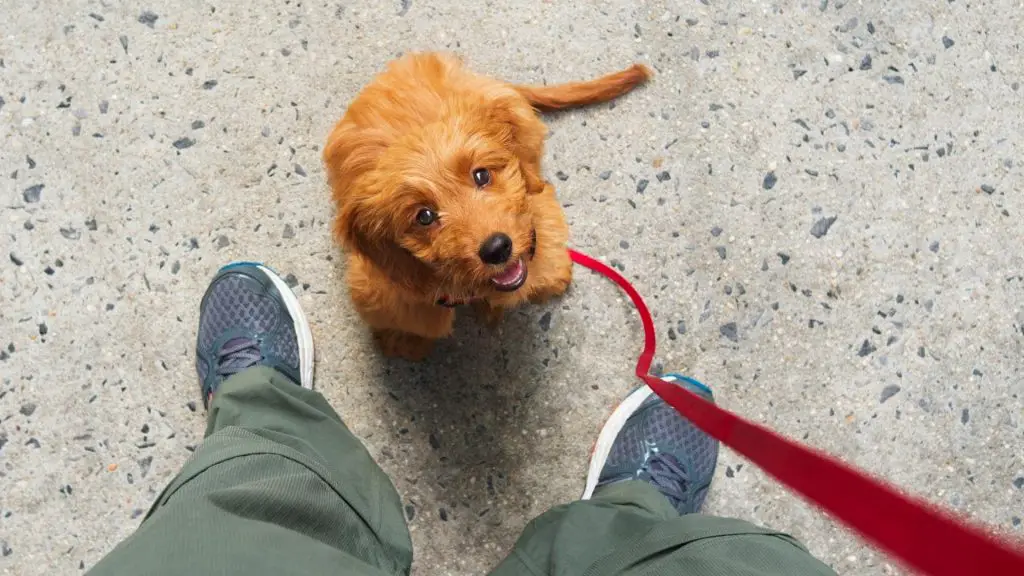
1.) Get Your Puppy Used To Collars And Leashes
When your puppy is unfamiliar with a leash or collar this might make them feel uncomfortable. That’s why making sure your puppy is familiar with these things is crucial for their success.
You can start by simply leaving their collar on all day as well as a puppy line (more on this in step 3).
Not only should you be leaving these on but you also want to train them to be okay with you grabbing and controlling them using these things.
This can be done by simply grabbing their collar, tugging it a bit, moving them around, all while feeding them treats as you do this.
This will help build positive associations with all of these actions.
2.) Use A Puppy Line Inside
The leash is for controlling your puppy where they can and can’t go. This can be for inside and outside.
Some dog owners will decide not to use a leash inside because they believe their puppy is ‘good’ off-leash indoors.
However, over time your puppy can develop bad habits that could have otherwise been avoided.
Using a puppy line indoors allows you to keep them in line while also getting them familiar with the idea of a leash.
Anytime you move and control them indoors with this puppy line, it will make it easy to then transition to walking them with a leash outdoors.
3.) Gather The Tools Needed
For any form of dog training you need the appropriate tools for the job. This means having your leash, collar, doggy treats, or toys (for the non-food motivated dogs).
You can include anything else you know your dog loves that could be used as a reward for good behavior.
Here are some of our favorite products:
Long Leash – Hi Kiss Dog/Puppy Obedience Recall Training
Short Puppy Line (For Indoors) – PETBABA Short Dog Leash
Regular Walking Leash – Joytale Reflective Dog Leash
Retractable Dog Leash – TUG 360° Tangle-Free
Doggy Treats – Top Reviewed Treats On Amazon
Collar – Joytale Reflective Dog Collar
4.) Set An Appropriate Challenge
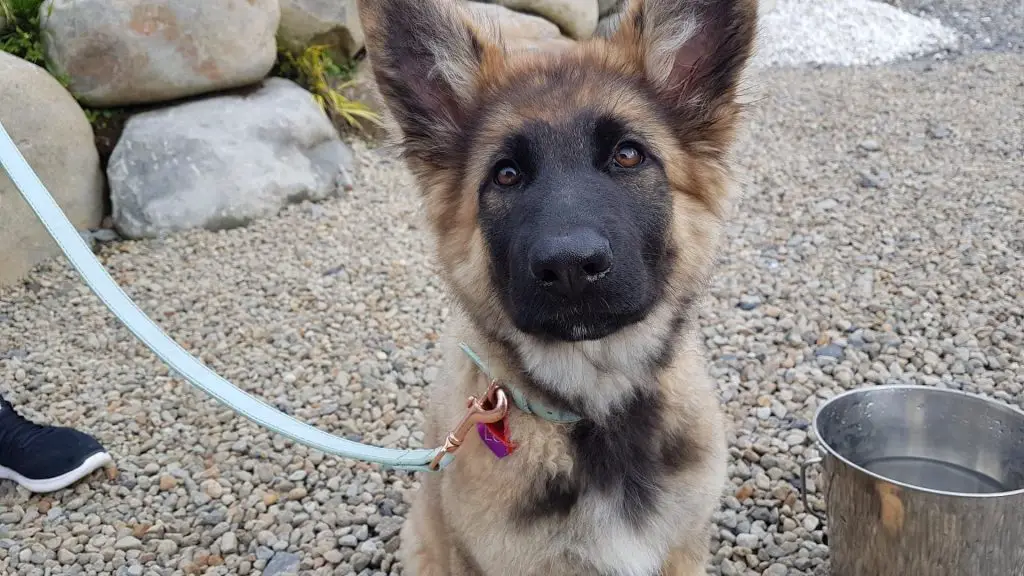
When training your dog on a leash you first want to set up a plan that is achievable for your dog.
Dogs have short attention spans so we want to make sure we are not setting an unrealistic goal for them.
We want to motivate our dogs to want to do something, not just tug them around forcing them to do everything. This will make training much more difficult.
So in order to do this we need to determine the distance, duration, and control the distractions (also known as the three D’s in leash training).
Distance
Pick a short distance for them to walk that you think they can achieve without problem. A good rule of thumb is to start with about 10-15 feet.
Distractions
Control your puppies environment when leash training them. Make sure you take them to an area where there is nothing for them to get distracted by.
This could be a parking lot, your driveway, a park, etc. It does not matter so long as you have an area without distraction.
We want to make this as easy as we can for them.
Duration
As I already mentioned puppies have short attention spans. So we want to limit the duration of our leash training sessions to a few minutes.
That way we can maximize our training in those few minutes and end the training on a win. This is extremely important for keeping our pups motivated.
5.) Practice Proper Training Methods
Now that you understand how to set a proper structured training session it’s now time to understand how to execute.
First and foremost, you never want the leash to be tight during training. You always want the leash to be loose.It should almost form a perfect ‘J’ shape when you hold it. That indicates it’s loose, there is no pulling, and you still have control if they get distracted.
Next, as you are showing them how to walk beside you, you will want to set up trigger words, actions, or phrases that lets your dog know they are about to get a reward.
Some people use clickers, words like “yes”, or they cluck their tongue. Whatever method you choose, anytime they follow instructions, make the sound and give them their reward.
At first, you can use treats to hold them out in front of your dog while you walk. This is simply guiding them to walk forward with you.
Don’t give them the treat right away though, simply hold it in front of their nose, start walking a few steps, then make your trigger sound and give them the treat.
This is the basic strategy you will repeat over and over until they understand how to walk beside you.
You can throw in some stops as well where you get them to sit down beside you. In addition, you can get them to sit down, then look up at you by saying their name.
Getting your dogs attention onto you is important to include in your leash training. So make sure every so often you say your dog’s name or say “look at me” and reward them when they do.
Depending on your dog you may need to replace treats with toys or just use very highly valued treats such as little pieces of chicken or meat.
6.) Praise Any And All Good Behavior
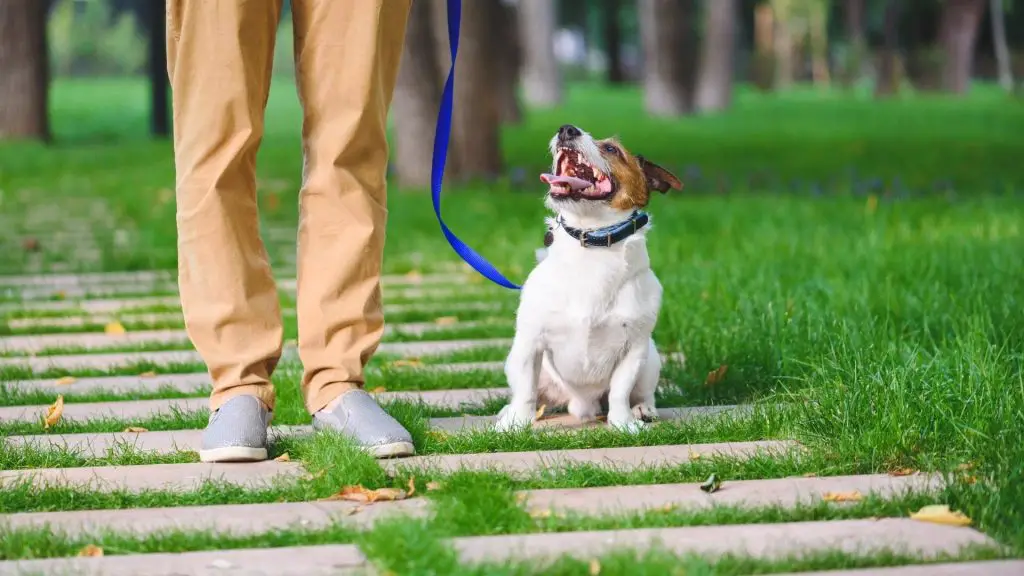
Positive reinforcement is the highest recommended training from dog behaviorists. There have been countless studies done comparing different methods and positive reinforcement always proved most effective.
The idea behind this form of training is to use a reward based system for good behavior. It also means simply ignoring bad behavior and avoiding punishment.
It’s okay to tell your dog ‘no’ and indicate to them that they are doing something bad but we do not want to punish them.
7.) Start Leash Walking In Control
Before you start your puppy leash training session, have the leash in a loose position with your dog sitting by your side with treats in your hand ready to go.
If you try to start walking them without first gaining control, it makes things much harder for you.
8.) Be Tolerant Of Their Mistakes
It’s normal for dogs to get distracted and for them to make mistakes. Being understanding and patient with them is going to be critical for their success.
Remember, for the first couple of months when leash training your puppy it’s going through so many phases of development.
They are growing bigger, stronger, becoming hormonal, etc. So it’s important to be patient with them as you train.
They might not even realize they started pulling you, or are walking faster than you, so give it time and keep working at it.
Eventually they will start to understand how to walk properly so long as you properly train them and stick with it.
Bonus Tip: If your puppy is particularly rambunctious during leash training, try doing some little training exercises before taking them out on the leash.
9.) Know The Right Pace For Your Puppy
Knowing how fast or slow to walk when training your dog can vary depending on your dog. Higher energy dogs will likely benefit from a faster pace than their counterparts.
If you set a pace that is too fast, your dog might jump up or get overly excited.
If you walk too slowly, you will make things a lot harder for your dog.
A good rule of thumb is to walk like you are late for something. This will engage your puppy and keep them more excited with you.
You will know when you are walking at the right pace when your dog has some excitement but not too much and they are not trying to walk way ahead of you.
10.) Use More Turning In Your Puppy Leash Training
For some dogs that are really high energy, throwing in some turns in your training can make it fun for them.
Especially for dogs that like to lead and walk in front. However, we do not want to overdue this.
11.) Plan How To End Leash Training
When you are about to end a training session, slow down your walk and lure them up and into sitting down with the treat in your hand.
You can then release them from the sit position by saying “ok”.
If your dog loves toys and is less food motivated you can end your training by getting their attention onto a toy. Then say “ok” and play with them and the toy.
How To Stop A Puppy From Biting The Leash?
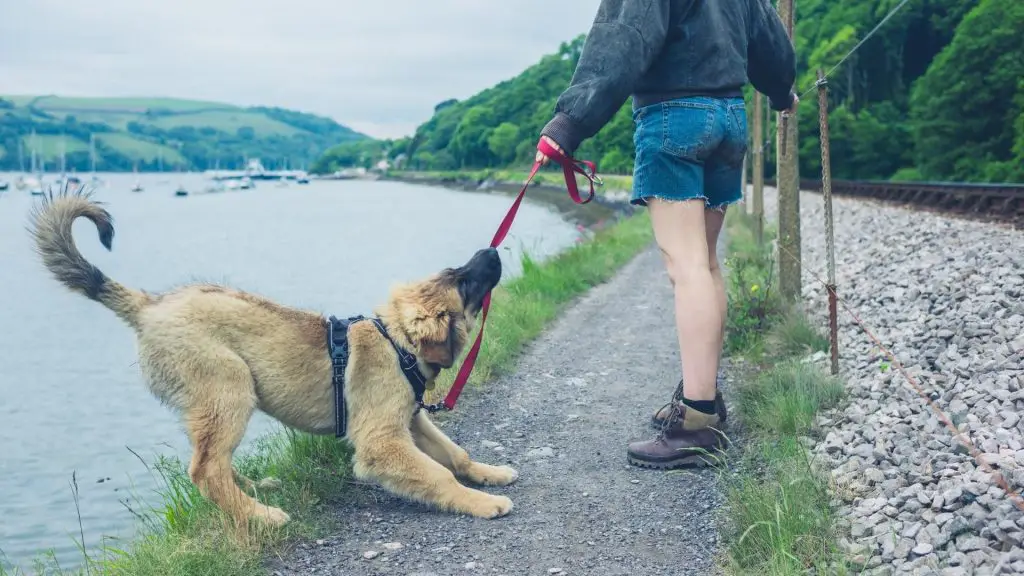
If your dog is biting on their leash, use a treat to take their mind off the leash. Do not give them the treat right after biting the leash. Get them to sit before giving them the treat to avoid you indirectly training them to bite the leash to get a treat.
In addition, if you have a word you’ve been repeating when they misbehave, use it here.
For example, if your dog is biting the leash you can say “no no” and when they drop it, give them a reward and praise.
This will train them that “no no” or whatever word you chose to use, means they are miss behaving. Plus they will know if they stop, good things will happen.
Quick note: if your dog does not really care for food or treats, find a toy or something they love. Use this in replacement of treats whenever they stop biting the leash.
How To Stop A Puppy From Pulling On Leash?
How you stop a dog from pulling on a leash is to first stop moving. Refuse to move until your dog decides to come back to you and stop pulling. Avoid yanking and pulling the leash, all your dog needs to know is when they pull, you stop moving.
Once they return to your side you can start walking again. Repeat this over and over anytime they pull on the leash.
As soon as they stop pulling and come back to your side and start to walk normally, praise them, and give them a treat.
Over time the pulling will stop but it will take consistency and repetition.
Puppy Leash Training FAQs
Should You Use A Collar Or Harness?
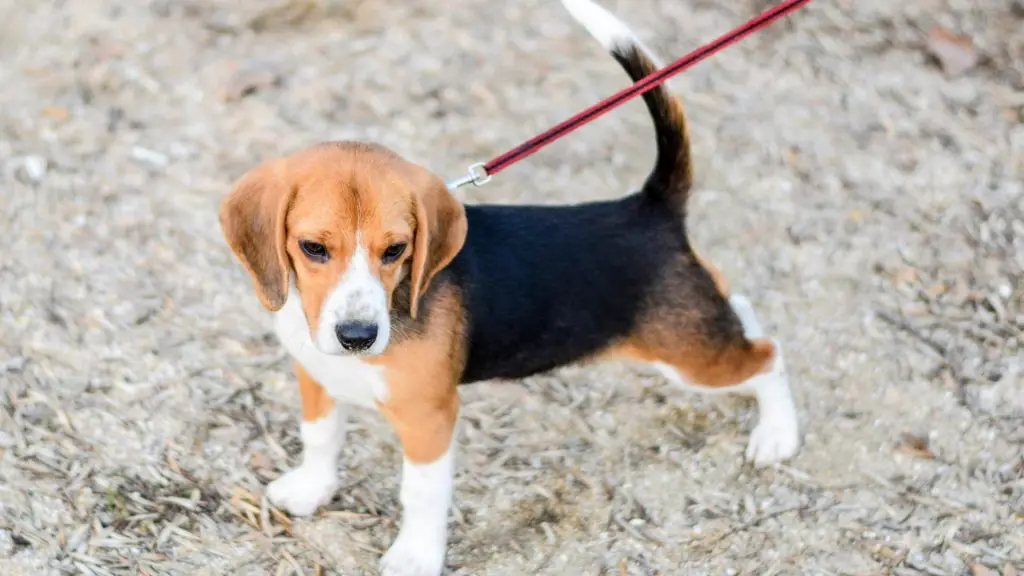
Ditch The Harness – You only want to give your dog a harness once they know pulling is not okay. Your dog needs to have clear information when first learning how to walk so having more control over their neck and head is much better at these early stages.
We are able to give them clear information when using a collar due to the pressure on their neck and better control of their head.
What if your dog pulls so hard they choke?
If this is the case then you are doing it wrong! The leash should never be tight during training. It should be loose and almost making a ‘J’ shape.
If your leash is tight during training or on walks this is improper training.
How Do You Leash Train A 3 Month Old Puppy?
The best way to leash train a 3 month old puppy is to start with basic obedience commands such as sit, stay, come, and down. Once your puppy has mastered these commands you can then start leash training.
When you first start leash training use a collar and leash that are comfortable for your puppy. Start inside your home then once they get the hang of it take them on short walks around your neighborhood.
Other posts you may find interesting:
11 Ways To Get Your Dog To Stop Digging (#6 Is Hilarious)
12 Tips To Get Your Dog To Stop Peeing Inside (#5 Works)
7 Simple Steps To Get Your Dog To Stop Barking
Citations
How to Teach a Puppy to Walk on a Leash
How to Leash Train a Puppy
How to Leash Train Your Puppy
Introducing A Puppy To Walking On A Leash
How to Teach a Puppy to Walk on Leash
